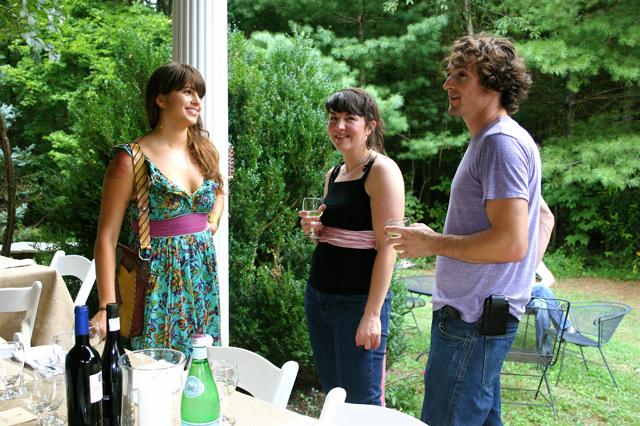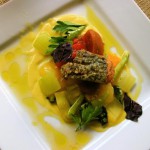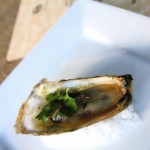- Three’s company: Gabriella Oviedo, Jael Rattigan and Dan Rattigan enjoying “social hour” before the main event at the Blind Pig Supper Club. Photos by Mackensy Lunsford
- Standing guard: The owner of The Admiral, Drew Wallace, checking his list to make sure no one crashes the Supper Club.
- Bass relief: Wild-caught striped bass en escabeche in corn jus with tomatoes and fresh summer herbs.
- The world’s our oyster: The first course featured a Harker’s Island oyster with a peach-moonshine mignonette.
Standing in front of a crowd of people awaiting a dinner of obscure meats, Elliott Moss admits, almost sheepishly, "This is our first time cooking all this stuff, so I hope it's good.” Drew Maykuth appends, matter-of-factly, "I'm surprised by how normal this stuff actually tastes,” as if to comfort the crowd.
Moss and Maykuth, both chefs at The Admiral, have been busy all day in the kitchen cooking (mostly braising) a larder of wild-caught fare, but they're far from the tiny and dark Admiral in more ways than one.
Many of the guests gathered for the inaugural session of the Blind Pig Supper Club have done a little sleuth work to secure a reservation to the underground event — and that’s part of the allure. Supper clubs are a growing trend in cities with a viable and thriving food scene like ours. The concept has been cooking in larger cities such as Charleston, S.C. San Francisco, Calif. and New York City for years — and is finally catching on in our neck of the woods.
A supper club is guerrilla dining at its finest. It takes the chefs and the guests out of the restaurant and into a unique culinary experience that likely won’t last past the end of the night. What’s the point? It’s simply a fun, relaxed and somewhat edgy celebration of food and the talent of the chef without the constraints of a restaurant. It’s the perfect experience for the type of diner that would risk an awkwardly cooked meal for the chance to try something new. These are the playgrounds for people who will devote an entire evening (and a bit of cash) to savor a previously unknown-to-them edible item with a table of equally food-curious cohorts. Supper clubs and weird meats, for this very reason, seem to make perfect bedfellows — and tonight, we have the chance to sample beaver, hunted exclusively for the Blind Pig Supper Club by Lucky the Trapper.
"There aren't many supper clubs out there that have their own hunter/trapper/fisher that can forage these things for the meals," acknowledges Michael Moore, an Asheville chef since 2003 and the mastermind behind Blind Pig. Moore says the ultimate success of his supper club will rely upon the skills of the chefs and the receptivity of the guests who must sign up to eat a meal in a mystery location, the identity of which they won't learn until hours before the dinner. "The entity is a lot of us, not just one of us," Moore says.
From the vantagepoint on the porch where our table is situated, we’re drinking in the view of the mountains (and sipping pinot grigio) and feeling like we lucked out on our “secret” location. Beyond the thicket of trees that partially obscures the mountain view is the 160-acre rolling expanse of Craigsfield Farms. We passed through those fields to get here, bouncing over a gravel road, eyes peeled for the next Blind Pig sign to affirm that we were headed in the right direction.
And here we sit, listening to the chefs acknowledge that, yes, this stuff is weird. But you're probably going to dig it. The menu for the evening, placed ever so neatly on the burlap tablecloths at each setting, provokes a double-take. There's snapping turtle, plus feral pig and nutria — basically a swamp rat with orange-toned beaver-like incisors (at least that’s how I describe the animal to the chocolatier seated on my left who looks game, yet none too pleased about the prospect of eating such a thing). And beaver? That's on the menu as well, also braised.
But while the average diner might shrink from a six-course meal of unfamiliar animals, this crowd, by all appearances, appears to be the daring type. It's clearly not amateur hour; over there sits a chef who learned the proper way to clean and cook calf brains from her mother.
There’s a restaurant owner who routinely buys entire animals for cooking and knows exactly what to do with them. And across from me sits a frequent dining companion who's been known to happily sample pig feet, cow testicles, duck hearts and fish sperm without so much as blinking an eye.
Should anyone experience a nervous edge, that jar of moonshine on the table (or that one over there) should serve to steel the nerves. Or maybe that 12-year-old bottle of Côtes du Rhone that someone's unearthed from their private cellar, uncorked and passed around the table for everyone to try — that might do the trick, too.
Swamp rat — it’s what’s for dinner
The first course of the evening, Harker's Island oysters, splashed with peach-moonshine mignonette and crowned with a touch of cilantro sent a clear signal from the chefs of The Admiral: you may have taken us out of our kitchen, but not our element. And if the offering isn’t terribly obscure (what with legal moonshine available locally now) a dish of snapping turtle most certainly can bear that distinction, even when served with accompaniments as warm and familiar as bacon and oyster mushrooms over grits.
The thing to remember, says Moore, is that such ingredients — and the swamp rat with the odd choppers — were mainstays of the Southern table, especially when money was scarce.
"Snapping turtle has been on the dinner table in this region for a while," says Moore. "Turtle soup is something that my grandmother remembers as a child," he says. And part of Moore's motivation in serving these rather odd-seeming foods for this particular dinner, he says, was to pay homage to the heritage of this region. "There's a lot of history with these types of foods. These are foods indigenous to this area that perhaps 80 years ago were definitely on the table," he says. "Back then, it was a way of life."
Even swamp rat? "Nutria is very big in underground Cajun and Creole cuisine," Moore says. "Of course, you don't often see them in restaurants. A lot of this food comes from, excuse the expression, the 'poor folks' table.'" It's likely that the people whose financial circumstances dictated they eat such things would howl with laughter if they knew what we now willingly pay for the experience of sampling these “peasant” foods. There was certainly nothing “poor” about the deftly executed escabeche of wild-caught striped bass, served with flavorful tomatoes and pole beans, opal basil and a rich corn jus.
Full-sensory history
Sampling these historically accurate ingredients, somewhat ironically, has become part of a progressive way of thinking about food, a re-imagining of dishes older than classic in an era when “heirloom” is haute cuisine. The way that Moore and the rest of us at that dinner see it, including the chefs who are tickled pink to work with beaver and feral pig, we're getting to experience history in an intimate, full-sensory way.
Even the setting for the dinner is rich with culinary heritage. Ron Ainspan, one of the owners of the property and the owner of Mountain Food Products, a local produce distribution company, speaks about the farm and its history of food production as we tuck into our meal. "This land," he says, sweeping his arm toward the wide-open fields that lie beyond the tree-line of spruce, maples and tulip poplar, "has been a food incubator for the community for a long time."
As the wine flowed, the conversation turned toward many things; food as a unifying force, "like art,” how that Nutria was the best aquatic rodent any of us had sampled (which isn't saying really much at all). The duck-flavored farro and andouille sausage was its saving grace.
Off-color jokes abounded when the beaver arrived. But the dish was no laughing matter, with its rich sauce of San Marzano tomatoes over pillowy and perfect gnocchi and pecorino Romano that had been given the foam treatment. The combination outshone all others, though some insisted that aromatically braised snapping turtle (it did have an impressive depth of flavor) was the evening’s highlight. But it left some of us wondering what turtle really tasted like — how our grandmothers might have made it.
"If you want to invoke history…" the chef sitting across from me began thoughtfully, "… then tie the flavor to history."
"But," I said to the chef, now deep into the moonshine. "What if turtle tastes like ass?" Mistaking my meaning, the chef launched into an intricate discussion of the flavor of donkey meat. It was too fascinating to halt with clarification.
By then, the feral pig had arrived, heaped and barbecue-smoky, served with crisp corn and butter as it likely had been before — maybe on that very porch. History, suddenly, didn't seem so distant. A breeze drifted across the candlelit porch where we'd been sweating, not uncomfortably. "The air blowing through makes me feel like I'm in love," the chef said, all moonshine and wine-happy.
Just then, Maykuth nearly knocked me in the head with a rough-hewn slab of wood he had topped with a dessert of salted watermelon slices sprinkled with basil chiffonade, startling me out of my reverie. He then placed a jar of high-octane moonshine in my hand, and the near-braining was forgotten.
Not all Blind Pig suppers are so meat-heavy, and likely you won't find beaver or nutria at any of the future events — although it's not out of the realm of possibility. To learn more and to purchase tickets for future events, visit blindpigofasheville.com.
— Mackensy Lunsford can be reached at food@mountainx.com.








Before you comment
The comments section is here to provide a platform for civil dialogue on the issues we face together as a local community. Xpress is committed to offering this platform for all voices, but when the tone of the discussion gets nasty or strays off topic, we believe many people choose not to participate. Xpress editors are determined to moderate comments to ensure a constructive interchange is maintained. All comments judged not to be in keeping with the spirit of civil discourse will be removed and repeat violators will be banned. See here for our terms of service. Thank you for being part of this effort to promote respectful discussion.